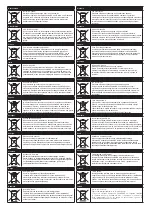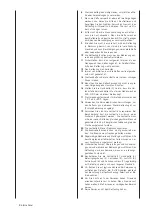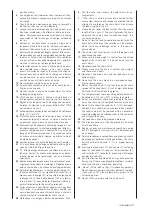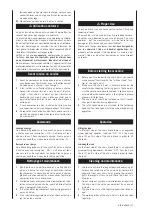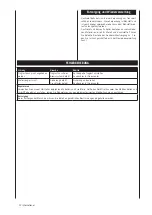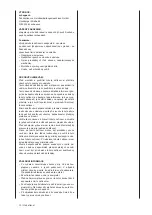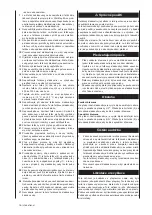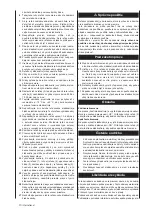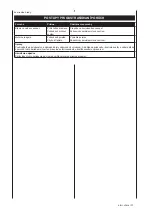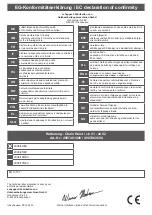
international 9
position stable.
5
La charge doit tenir fermement dans le crochet. N’es-
sayez pas de lever la charge avec la pointe du crochet
de charge.
6
Tirez la chaîne de manoeuvre de façon uniforme afin
d’éviter les chocs ou les emmêlements.
7
Lorque la chaîne est bloquée ou qu’elle ne peut plus
être tirée, arrêtez-vous. Contrôlez et éliminez le pro-
blème. N’essayez pas de manoeuvrer le palan à chaîne
avec violence. Ne laissez pas la charge suspendue
en l’air.
8
Veuillez ne pas descendre la charge au-delà de la
longueur utilisable de la chaîne. Lorsque la chaîne est
fortement tirée entre la roue à chaîne et la goupille
d’extrémité de charge, des dégâts peuvent être causés.
9
Ne permettez pas que la charge vienne en contact avec
le palan à chaîne, sinon le pivotement libre se bloque
et peut entraîner des endommagements, l’emmêle-
ment de la chaîne ou le blocage de la roue.
10
Le fonctionnement du palan à chaîne doit être aussi
bien contrôlé avec « charge » que « sans charge »
avant l’utilisation de façon suffisante et minutieuse.
11
Assurez-vous que le poids de la charge est inférieur
au poids nominal du palan à chaîne. En cas de doute,
veuillez ne pas utiliser le palan à chaîne.
12
Ne surchargez jamais le palan à chaîne.
13
Assurez-vous toujours que les chaînes sont bien ver-
ticales et sans noeud.
14
Ne tirez jamais la chaîne de manoeuvre et la chaîne
de levage en diagonale.
15
N’utilisez pas le palan à chaîne à chaîne dans un
environnement explosif ou dans des salles humides.
16
Réglez la chaîne portative (2) de façon que son point
de retour se trouve à une hauteur entre 500 et 1000
mm au-dessus du sol.
17
La température ambiante des entrepôts doit se trouver
entre -10°C et 50°C.
18
N’utilisez aucun dispositif électrique dans le but de
manoeuvrer le palan à chaîne. Le palan à chaîne est
uniquement conçu pour une commande manuelle.
19
N’essayez pas de réparer la chaîne de levage. En cas
d’endommagement, la chaîne de levage peut être uni-
quement remplacée par un spécialiste. La chaîne de
levage doit être remplacée avec une nouvelle chaîne
du même acier soudé et trempé, de même taille et
de même épaisseur.
20
Veuillez graisser la chaîne de levage avant l’emploi.
21
21. Les surfaces de freinage ne doivent pas être grais-
sées. Le frein doit être gardé au sec.
22
22. Effectuez régulièrement un contrôle et une main-
tenance. Toutes les pièces endommagées ou défec-
tueuses doivent être remplacées par un personnel
spécialiste.
23
Réalisez les procédures de sécurité, contrôles et grais-
sages avant et pendant le maniement. N’opérez avec le
palan à chaîne que s’il est dans un état réglementaire.
24
Contrôlez régulièrement la chaîne porte-charge (1),
la chaîne portative (2), les crochets de fixation (3), le
crochet pour la charge (4), la cheville de blocage de
la charge (5), la roue d’entraînement (6) et la ferme-
ture à déclic (7) pour détecter d’éventuels défauts,
particulièrement après des arrêts prolongés.
25
Faites attention à tout défaut apparaissant pendant
l’utilisation. Si quelque chose ne vous semble pas
normal pendant que vous utilisez le palan à chaîne à
chaîne, mettez-le immédiatement hors circuit.
26
Ne levez pas la charge au-dessus de personnes. N’au-
6
Pull the hand chain evenly, to avoid thrusts or en-
tanglements.
7
If the chain is barred or cannot be pulled further,
please stop. Examine and resolve the problem. Do not
attempt to use force on the chain hoist. Do not leave
the load hanging in the air.
8
Please do not lower the load further than the usable
length of the chain. If the chain between the chain
wheel and the chain pulley is pulled too taught, this
can cause damage.
9
Do not allow the load to come into contact with the
chain hoist, otherwise free rotation will be blocked,
which could cause damage, knots in the chain or
barred wheels.
10
The chain hoist functioning must be thoroughly and
adequately checked.
11
Make sure the load weight is smaller than the stated
weight of the chain hoist. If in doubt, do not use the
chain hoist.
12
Never overload the chain hoist.
13
Always make sure the chain is vertical and straight,
and there are no knots.
14
Never pull the hand chain and the load chain at an
oblique angle.
15
Do not use the chain block in an explosive environ-
ment or damp rooms.
16
Adjust the hand chain (2) so that the point of chain
reversal of the hand chain (2) is at a height of between
500 and 1000 mm above the ground.
17
The temperature of the surrounding atmosphere must
be between -10°C and +50°C in order to operate.
18
Do not use electrical appliances to operate the chain
hoist. The chain hoist is designed for manual use only.
19
Do not try to repair the load chain. If it is damaged,
the load chain should only be replaced by an expert.
The load chain must be replaced with a new one of
the same welded and hardened steel, in the same size
and strength/thickness.
20
The load chain should be greased before use.
21
The brake surfaces must not be greased. The brake
must be kept dry
22
Regular checks and maintenance should be carried
out. All damaged or faulty parts must be exchanged
by an expert.
23
Safety procedures, examinations and greasing should
be carried out before and during operation. The chain
hoist should only be used if it is in proper working
order.
24
Examine the load chain (1), hand chain (2), fastening
hook (3), load hook (4), load pin (5), drive wheel (6),
and latch lock (7) for defects, especially after longer
periods of standstill.
25
Pay attention to any defects which may have occurred
during use. If there are noticeable problems, immedi-
ately stop the chain block from operating.
26
Do not lift the load so that it is above any persons.
Do not allow any persons to walk underneath the load.
If you wish to lift a load, please warn anyone in the
surrounding area.
27
Do not lift any persons with the chain hoist.
Summary of Contents for 4907401000
Page 23: ......


